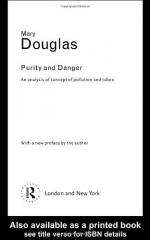|
This section contains 478 words (approx. 2 pages at 400 words per page) |

|
Chapter 7 Summary and Analysis
Society has internal and external boundaries just like the structure of organisms that relate to social forms. Rituals specify the details of the action for specific reversals. In the same way, the human body is a complex system with functions.
Through the comparison of primitive and modern cultures, different patterns of achieving desires emerge. Primitive cultures have been regarded to manipulate and subordinate women while modern cultures can directly effect external environment. Also, primitive cultures were to have incomplete personalities and psychological shortcomings. Douglas proves that primitive cultures are falsely thought to be both primitive and neurotic. Their treatment of dirt as creative power shows aspects of complexity rather than infantilism.
The body dirt is regarded as being powerful as part of the ritual, such as blood in the Hebrew religion that was to be the source of life and thus...
(read more from the Chapter 7 Summary)
|
This section contains 478 words (approx. 2 pages at 400 words per page) |

|




